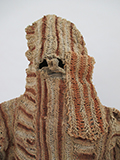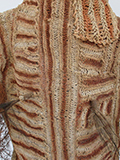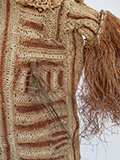The Asmat people are located in Papua New Guinea, in the area specifically referred to as the Asmat region on the southwest coast of the island. The Asmat territory is divided into twelve regions and includes many subgroups all with their own dialects and differences. These regions are grouped together because of similar linguistic features in their languages.
The mask -- a full body mask -- in the Nowes Ark Collection, pictured below in Figures 1 and 2, is similar in style and appearance to the fum in the Lowell D. Holmes Museum’s Downing Asmat Art Collection housed at Wichita State University. It is also similar to fum in the Michael C. Rockefeller Collection in the Metropolitan Museum of Art in New York City.
Figure 1: Front |
Figure 2: Back |
 |
 |
The Asmat’s spiritual practice includes strong connections to their ancestors, and the body mask is no different. There are two distinct ceremonies that use masks which are different for each ceremony. Anthropologist Pauline van der Zee differentiates the them as "a secret mask" and "a joking mask." The joking mask, called mbanembar or mamawas, is more rigid and basket-like, and is meant to be comical. The secret mask, called fum, holds more important cultural meaning and is taken very seriously. It is worn during ceremonies marking death. The Asmat believe that when a member of the community dies, their spirit lingers for a time and puts the village at risk. The specific purpose of the jipae festival is to rid the village of all ancestral spirits trapped on earth since the last jipae ceremony by sending them fully into the spirit world while at the same time commemorating their memory.
Creation Process
The creation of the fum mask is ritual in itself. It takes several weeks to create and is made by the same man who wears the mask during the ceremony. The fum consists of two parts: the bodice made from finely twisted cord made from the inner bark of a paper mulberry tree, and the grass skirt attached to the bottom and sides of the mask made from the sago palm tree leaves. Figure 3 below shows a detail of the left shoulder of the mask where it is unraveling which allows the viewer to see strands of bark rope and how they were twisted together to create the cord used for braiding. Figure 4 below is a detail of the inside of the mask and shows the chevron pattern created by weaving, braiding, and looping techniques.
Figure 3: Left Shoulder Detail |
Figure 4: Interior Detail |
 |
 |
The Bodice
The bodice covers the torso and head, with small openings for the eyes and mouth, and is meant to conceal the body and it’s movement beneath. The bodice of the mask that requires the most skill and time to create. More consistent weavers will produce masks with fewer irregularities, but to the Asmat, these irregularities and differences between masks mark the character of the ancestor they represent. The making of the bodice starts with the creation of bark rope. The bark is rolled between the soles of the feet and the palms of the hands, and the fine cord, or twine, that results is used exclusively for mask-making. Small quantities of this sacred cord are made by individual members of the community, and given to sponsors of the mask.
The fabric of the bodice has a woven / braid-like appearance, with rows of chevrons formed by the cord, as can be seen in Figure 4 above and Figures 5 and 6 below. The braid is made by passing the cord through a series of loops with the aid of a small awl and is a single-element looping technique.
The mask is then constructed by inter-looping larger patches of braided cord together, which causes irregularities at seams where two sections of braided cord come together, as seen in Figure 5 below. Figure 5 also shows how patches are attached on the surface when deterioration requires their use. The eyes and mouth holes of the bodice are formed simply by weaving in a few strands of braided cord, as can be seen in Figure 7 below.
Once the bodice is completed, red and white stripes, made from ochre and limestone, are painted onto it. Figure 6 below is a detail of red ochre and white limestone painted in vertical stripes on the mask. Red and white coloration alternates on every other chevron-woven pattern.
Figure 5: Detail of Construction |
Figure 6: Detail of Painting |
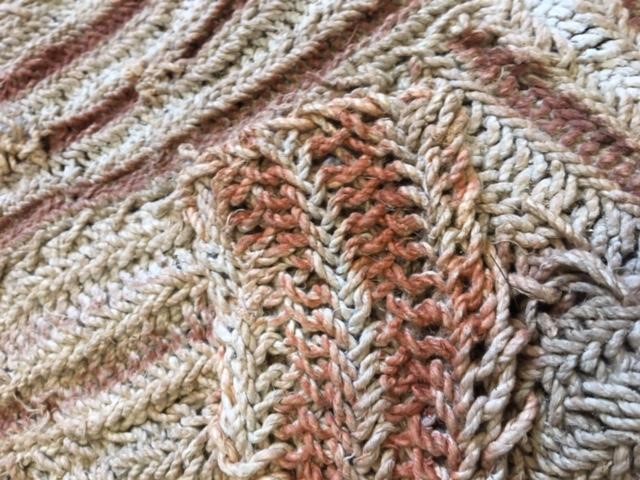 |
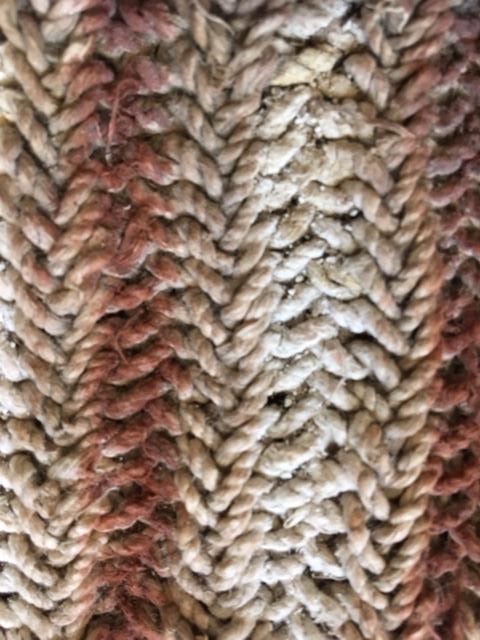 |
Figure 7: Detail of Eyes, Nose and Mouth |
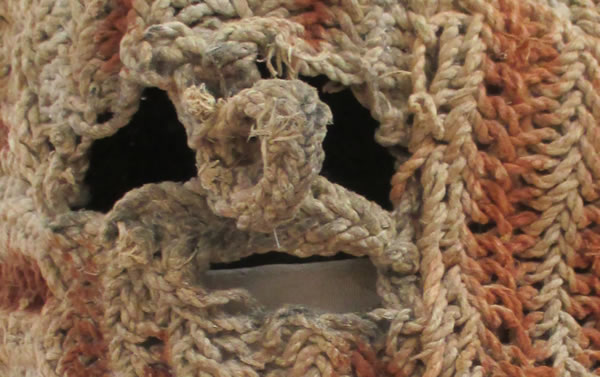 |
Skirt and Sleeves
No Asmat mask is complete without an attached skirt and sleeves. The fiber skirt attached to the bottom of the bodice and on the sleeves is made from stiff juvenile sago palms, which are cut into thin strips and tied into bundles after which they are soaked in the river to make them supple. Once soaked, each strand’s thickness is cut in half with a knife and the hard backing of the frond is removed. The softer side of the fronds are rubbed to further soften them, making the strips of palm pliable. The bunches of strands are folded, wrapped with sago cords at the fold to make a section of skirt, and are then hung to dry. When they are dry, they are made into skirts. The bunches of grass are attached to the bodice with unsoftened dark and light sago palm strands. A sharp point is cut into one end of a long sago strand, and the point is used to pierce into the bodice like a needle, and then is stitched across the bottom of the bodice as a regular straight stitch would be. Figure 8 below shows how strands of sago are bunched together and Figure 9 shows how the skirt is attached to the bodice portion of the mask. This weaving process used for the skirt and sleeves is the same one used for creating a basic mat used in Asmat interiors.
Figure 8: Bundles of Sago |
Figure 9: Skirt and Bodice Attachment |
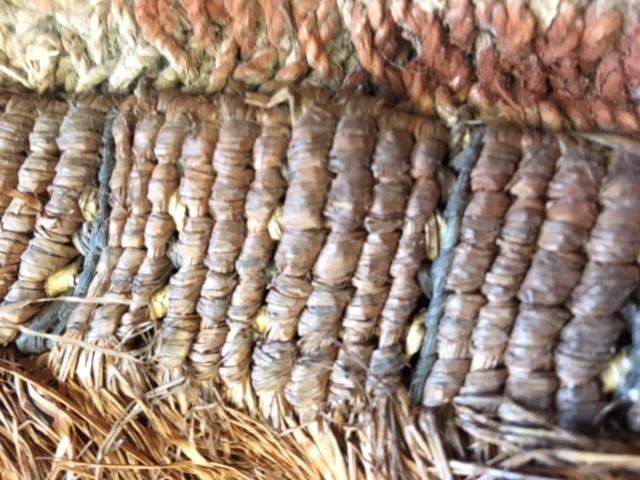 |
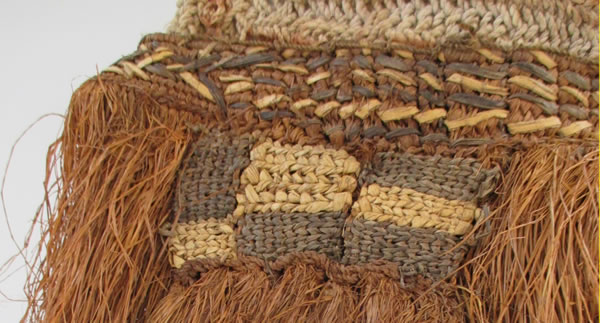 |
Decoration Elements
While the bodice and the sago skirts provide a base for the mask, the fum is not complete without important adornments. The fum mask in the Department of Dramatic Art is missing these adornments, but does have the woven loops where the decorations would be placed. Usually the mask would include a wooden nose piece, wooden ear pieces, wooden eye pieces, a cane stick with hanging cockatoo feather (piniw) attached to the back of the mask, and an artificially woven penis on the front. The fum mask in the Department of Dramatic Art's Nowes Ark Collection has one attachment that is still attached to the mask: two cassowary bird feathers are attached as imagined nipples to the mask, as can ben seen in Figure 10 below.
Figure 10: Cassowary Feathers |
Figure 11: Nose Loop for Bone Insert |
 |
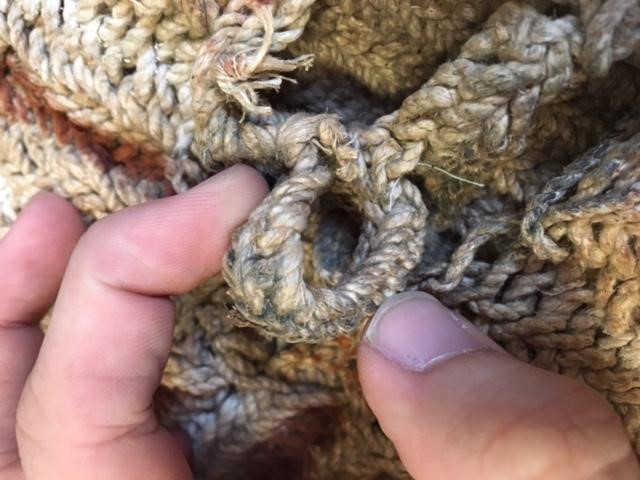 |
Most of the additional decorations that are attached to the mask are symbols of masculinity: the piniw cockatoo feathers are a symbol of a headhunting, as are the cassowary feathers worn by a skilled male hunter; an artificial penis is a male sex symbol and wooden nose pieces are worn by Asmat men as a nose ring accessory. The wooden ear and eye pieces are meant to mimic the shape of the hornbill bird’s head, a bird that is associated with rebirth in afterlife in Asmat mythology. Figure 11 above shows the placement where a wooden bone would be inserted on the front of the mask, and figure 12 below, on the center of the right side, shows where an artificial penis would be inserted. The Asmat believe that everything on earth has male and female elements to it, with the male component representing the spiritual world on top and the female component related to the earthly world below. The body mask reflects these ideas: Although predominantly male with its top adornments, sago fibres are associated with Asmat women who prepare sago as the Asmat’s primary food source, and the skirted sago accentuates movement to further associate the sago skirt with the feminine component. Thus the male adornments are attached to the bodice, or the top spiritual representation of the mask, and the sago skirt is attached at the bottom edge, where it is associated with the feminine connection to the earth.
Figure 12: Profile Detail |
 |
Conclusion
Even though the Asmat people have only been in contact with the Western world since the 1950s, artifacts such as the fum body mask have been collected, allowing scholars to study important parts of Asmat culture. Through contextualizing the Western world’s connection with the Asmat people, exploring the ceremonial meanings of the fum mask as an embodiment of an ancestral figure, and delving into the creation process of the mask and its distinct elements and how those elements represent the Asmat’s view on gender in the physical world. The Asmat fum mask is more than a piece of dress; it is a carefully crafted ceremonial object that is important to Asmat ritual and ancestral connection. The amount of time and effort put into the creation of fum is awe inspiring creating a window into a small part of the ritualistic life of the Asmat people.
© Connor Kirkpatrick, 2017



